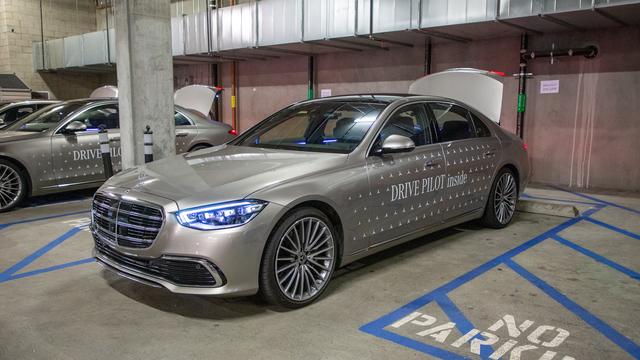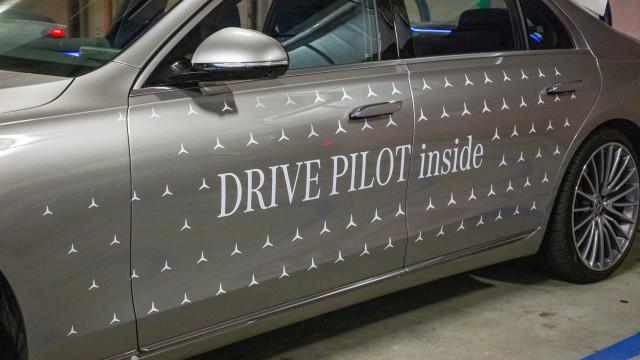
If it seems like Europe gets all of the cool auto stuff, that’s because it’s kind of true. More wagons, more diesel powertrains, and in recent history, better safety technology. But that may be changing in the U.S., as Mercedes-Benz demonstrated in a series of technical demonstrations in Los Angeles last week.
The demonstrated systems will push Mercedes-Benz beyond its current Level 2 autonomous driving aids to Level 3 and Level 4, meaning that in both cases the car will be driving itself and will not require human intervention. This also means that if a crash were to occur in either case, the company would bear the liability and not the driver—a key area of distinction between these new systems and similar technologies that are on the road today.
2022 Mercedes-Benz S-Class Drive Pilot Demonstration
Level 3: Drive Pilot
Drive Pilot is the name Mercedes has given to its Level 3 autonomous system that was approved for use in Germany last December and will launch this year on the S-Class sedan. It will be followed by the EQS electric hatch, though the timing for that is still unclear.
Currently, Mercedes has approval to test the system in California and Nevada. I hopped into a modified S-Class to test the system from the passenger seat alongside Michael Decker, manager of R&D for automated driving at Mercedes, who developed the system. After a quick walkaround of the car’s sensor and camera upgrades, we set off in the late morning from Santa Monica in search of a traffic jam.
The system only works at speeds of 40 mph and under, which is why we’re hunting for traffic instead of avoiding it, as Angelenos usually do. In Germany, it’s limited to 60 kmph by law, and though there are no such restrictions in the U.S. that’s where Mercedes says it’s comfortable starting out with the system, with the hope of eventually expanding it to work at highway speeds. Similar to GM’s Super Cruise and Ford’s Blue Cruise systems, it only works on mapped divided highways. Mercedes has partnered with Here, a Chicago-based company, that provides the road maps for this system in the U.S. and Europe.
2022 Mercedes-Benz S-Class Drive Pilot Demonstration
2022 Mercedes-Benz S-Class Drive Pilot Demonstration
2022 Mercedes-Benz S-Class Drive Pilot Demonstration
2022 Mercedes-Benz S-Class Drive Pilot Demonstration
To power the system, more hardware has been added around the S-Class, including a road moisture sensor in the wheel well to detect rain or a wet road that might change stopping conditions, ultrasonic sensors, a LiDAR unit up front, and an antenna array mounted towards the back window. The antenna array connects to satellites that help to determine the car’s position on the road down to the centimeter. Decker said the system is so sensitive, that it accounts for continental drift in real time. The two cameras around the rear-view mirror have also been widened to help the system render a more accurate 3D image of what’s happening around the car. In addition, the tester car had what looked like a server rack in the trunk to record the data collected by the system.
Having found traffic on the reliably crowded interstate 10, it was time to turn the system on. It is activated by one of two buttons on the steering wheel that light up white when the system’s conditions are met. After activating the system, those lights turn turquoise and another turquoise indicator on top of the steering column lights up as the car takes over.
2022 Mercedes-Benz S-Class Drive Pilot Demonstration
For the 15 minutes or so that we rode in traffic with the car, there was little to no drama, save for when an emergency vehicle was passing us in the other direction and the system shut off and asked the driver to take over. It tracked dead straight in our lane and worked smoothly to start and stop. The system does not yet have the capability to change lanes as some Level 2 systems will do automatically, but Mercedes says that will come eventually. If road markings can’t be detected, the car will continue along for six to seven seconds until it can reacquire its positioning before shutting off.
There are some conditions the driver has to meet to keep the car in its automated driving mode. You can’t climb in the backseat and if you try to scoot the seat back and lie down, a message pops up telling you that you must remain in reach of the pedals/wheels or the system will turn off. And the driver’s attention must remain fixed in what the vehicle considers “driver attention zones,” an area that includes the infotainment screen (on which Michael put on a YouTube video during our drive) and most of the dashboard. It does not include speaking to passengers: if the driver facing camera detects the driver speaking to the passenger or looking into the backseat for 30 seconds, a prompt warns the driver to turn back around, and after another 30 seconds it will shut off.
2022 Mercedes-Benz S-Class Drive Pilot Demonstration
2022 Mercedes-Benz S-Class Drive Pilot Demonstration

Getting the car to exit its automated mode takes more effort than deactivating Level 2 systems like adaptive cruise control, where a tap of the brakes turns it off. This system determines if the brakes are being applied harder than the system would in a given situation (far beyond a simple tap) and then turns off. The steering wheel is held firmly in the middle while the system is on; I was able to reach over from the passenger seat and it takes a pretty firm yank to get it to disengage. There’s no way you’d turn it off by accident with either method.
Mercedes says that so far it’s driven more than 50,000 test miles in California and Nevada, which doesn’t sound like much until you remember that it did all of those miles in traffic. Poor souls. It would be easier to do those miles at highway speeds, which Mercedes says is the next step for the system.
Pricing is not yet available for the additional features and equipment, but thankfully Mercedes indicated that the system won’t use a subscription model and only be a fixed up-front cost during vehicle purchase. Mercedes also said that as of now, it is the only legacy automaker to be testing this type of system in California or Nevada at the moment and is leading the way on regulatory approval. Once that happens, the floodgates will open and other brands will try to catch up as quickly as possible.
2022 Mercedes-Benz S-Class Drive Pilot Demonstration
The big difference between this Level 3 system and the Level 2-plus systems offered by other automakers (like Blue Cruise, Super Cruise, and Tesla’s Autopilot) is that Mercedes is taking on liability if the car crashes while the system is active. With the other systems, responsibility falls on the driver.
One potential complicating factor: Mercedes will have to go state-by-state for approval, without any standing federal regulations in place on this technology. So there is a scenario in which your EQS or S-Class will drive itself on the highway, but once you cross into another state the driver will have to take back over.
Mercedes-Benz EQS Automated Valet Test
Level 4: Automated valet parking
Going a step beyond that system was an automated valet parking system that was displayed in the parking garage of a hotel in downtown Los Angeles. The system was co-developed by Mercedes-Benz and Bosch, an automotive supplier, and is already in use at the Stuttgart airport but this is the first we’ve seen it in the U.S.
To activate the system, the driver parks the vehicle in a drop-off area at the parking facility and all passengers exit. Then via the Mercedes smartphone app, the system checks if a parking space has been reserved or is available and prompts the driver to handover the vehicle. Another tap of the screen and the vehicle moves (slowly) away on its own, destined for a parking spot in the facility.
Mercedes-Benz EQS Automated Valet Test
The process appeared very seamless in the demonstration, from getting out of the vehicle to confirming a parking space, and driving away took about 45 seconds. It then about a minute for the car to navigate a couple hundred feet through the garage, reversing into a spot next to another parked car. It’s important to note that Bosch installed sensors in the parking garage to guide the vehicle to the space, not the car’s safety systems and sensors. The big catch with this system is that for it to operate, it requires the installation of Bosch hardware and sensors to power it.
In the hotel parking garage, this meant that there were about 20 LiDAR sensors on metal plates lining the route the vehicle (an EQS in this case) took to the parking spot and it made the whole thing look cumbersome. But Bosch representatives assured us that this setup was only for this demonstration, because it was in a temporary location. In Stuttgart, there are no ground sensors, just stereo cameras installed in the ceiling that make the whole setup nearly transparent.
Mercedes-Benz EQS Automated Valet Test
Mercedes-Benz EQS Automated Valet Test
When you want the car back, the same process happens. The driver calls the car back using the smartphone app and it turns on then makes its way back to the drop-off area. After that, you just hop in and drive away.
The difference between this system and Tesla’s park and summon feature is that it happens without needing the driver to be present. Currently, Tesla’s feature requires the driver to be within about 20 feet of the car and to preside over its travel. This system is designed for the car to work more independently, and again in this application if something goes wrong the company is liable and not the driver.
Mercedes-Benz EQS Automated Valet Test
Parking garages and valet does feel like a very narrow application of this technology. While it may appeal to some luxury car buyers it seems that the greater use for this type of system is commercial. Whether it be at rental car counters, or at commercial shipping hubs where the system could maneuver vans or trucks to be loaded/unloaded and send drivers out with loads more constantly.
Mercedes and Bosch are also waiting for regulatory approval for this system in the U.S. and are hoping to find infrastructure partners to facilitate its installation. But both of these technologies represent an exciting step towards an expansion of automated driving technology.